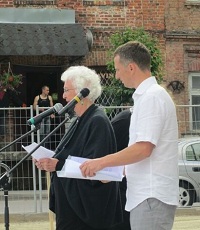Speeches
Following the welcome by the Zagare Seniune (local
administrator) Alvydas Urbonas, Sara Manobla served as
Master of Ceremonies.
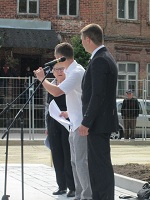 |
|
Pictured above (left to right):
|
Sara Manobla
People of Zagare, of Joniskis and Siauliai, Vilnius, Kaunas, Riga; and visitors from overseas – England, America, Australia, South Africa and Israel - we are so pleased you made the journey to be with us on this occasion.
My name is Sara Manobla. My family came from Zagare. Over 100 years ago my grandparents left for England – England is where I was born, although I have lived for most of my life in Israel. Our translator is Valdas Balciunas from Zagare.
We are gathered here this afternoon for the unveiling of a memorial plaque. It is a joint effort, the initiative of friends and supporters in the local community, together with Jews of Zagarean descent from overseas. The event itself, here in the Town Square of Zagare is very significant and very symbolic. This plaque is dedicated to the Jewish community of Zagare, and to the memory of those who were killed, on October 2, 1941, in this place, murdered by the Nazis and by their Lithuanian collaborators. World War II was a terrible period for the Jewish people, and for the people of the Baltic republics. Our gathering here today is an attempt to come to terms with the past, to acknowledge what happened, to nurture the spirit of reconciliation, to accept, to build trust and to remember. This is our goal
Our other guest of honour has come to us from Riga. We are
delighted to welcome Liat Wexelman, representing the Israel
Embassy to Latvia and Lithuania.
Liat Wexelman
Text unavailable.
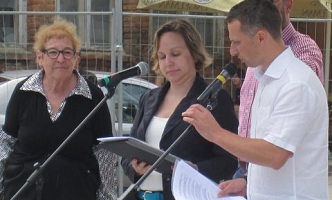 |
| Sara Manobla, Liat Wexelman and Valdas Balciunas (l-r). |
Sara Continues:
None of this would have happened without Joy – whom I am proud to claim as my cousin. Our grandfather David Towb came from Zagare - he married a local girl - Batya Muller, who was born in Zagare. Joy first came to this town in 1995, searching for family roots and links with the past. But she looked beyond history; she looked at the present and into the future. Lithuania Link, the NGO which she founded, built up a very special relationship between the UK and the people of Zagare, and out of it grew a bond of warm co-operation and mutual help. She and many others from Cumbria in the north of England have visited the town. Many of you know Joy, and value her and the deep friendships that have been made: Joy Hall.
Joy Hall
My grandfather (our grandfather - Urs) had been very fond of this town. My sister and I were curious & made our first visit to Zagare in 1995. We met Seniune, Zivile from the school and Aizaakas. Alas, Aizaakas is not here to share in this great event today. How proud he would have been. He carried the flame of remembrance all his life – indeed he told many of the Jewish visitors here today what happened in 1941, how tragic it was, how destructive. And we salute his memory.
When we first came to Zagare, we found a yearning amongst the people here to be part of “the west” and I promised I would try to help.
We formed an NGO – Lithuania Link. It organised many small self help projects led by skilled and generous individuals from the UK.
Education played a big role; the establishment of the youth club, environmental projects, exchanges between individuals here and the UK; there was a project to plant cherry trees (which we benefit from today), and specialist research into Lithuanian folk knitting. We've had a lot of fun! Lithuania Link gave a large grant for the very first Cherry Festival – the hunch that this was a brilliant idea paid off! In 2006 there was a memorable visit to Zagare when The Wordsworth Singers, a choir from the north of England, came here. We performed Jewish music, secular music, and a commissioned piece about Blessed Barbora, by Kristina Vasiliauskaite (who in turn, visited the UK).
I pay tribute to Alex Gibb, Director of Lithuania Link. His involvement over the years, his commitment and his leadership has been central to the blossoming confidence and energy demonstrated today. The building of interest and the development of responsibility between individuals and organisations in Zagare and the UK, through Lithuania Link, has inspired endless good, not just in Lithuania and the Baltic countries, but throughout the world.
One of the most positive achievements of all this work and effort is the lasting friendships created. Two relationships in particular I'd like to note – the marriage of Saulius from Zagare, and Sarah, from England. They have a bonny baby, Elena, whom I've just met. Also, Alex, from England and Egle from Vilnius, and their baby Monica. These partnerships are the true markers of Lithuania Link's legacy – that all people enrich each other’s lives immeasurably.
So I say Bravo to ALL people here today!
As one of the descendants of the Jews of Zagare, I am happy to be celebrating with you our lives, your lives, and the future of Zagare.
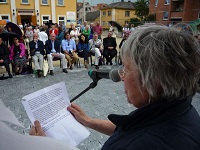 |
| Joy Hall |
Sara Continues:
Our next speaker is Cliff Marks, from Seattle, America and of Zagarean descent. Cliff is a town planner – now retired. Some 10 years ago, through Lithuania Link, he came to Joniskis to work with the municipal planning department, on the master plan of the town, and the restoration of historic buildings, including the synagogues. Cliff's second claim to fame is the website which he set up, called Zhagar Shtetlinks, on the Jewish community of Zagare - which has helped to bring many of us together: Cliff Marks.
Cliff Marks
Each descendant probably has their own reasons why this plaque dedication is important to them. First, our ancestors were born here so this is not just another place but a very special place and part of our heritage.
I think a large part of why this plaque dedication is important to us can be seen in the universal desire among immigrant groups to want to connect with the “old country” -- to search for their "roots". For most immigrant groups, like the Irish or the Italians, this is relatively easy - they may still have family in the old country and at least the old culture is still alive there. But for Jews it is different -- we don't have this connection because the old culture in the old country no longer exists. One can walk around Zagare today and see some old buildings that were once used by Jews, and three are marked as such. But the Jewish culture is certainly gone. However, this plaque right in the center of town will be a significant formal and physical recognition of the former Jewish community. Speaking personally, as was noted, I was Town - or Urban - Planner, so physical things in specific places are very important to me.
The other reason why this plaque dedication is so important to the descendants is that it is an acknowledgement by current Lithuanians of what happened in October 1941 when Zagare's Jewish community was destroyed. Some of us actually had ancestors or relatives that were killed right here. For example, Rod Freedman’s great grandparents and Rose Zwi’s family. But even for those of us whose ancestors left well before the holocaust, the final destruction of the Jewish community in 1941 is still very painful. And this plaque represents a recognition of this pain and a continuation on the path to reconciliation.
Finally, I want to note the three languages that are on the plaque. Lithuanian, of course, so people who live here will be able know about this history. English because that is a language understood by most visitors from other counties. And Yiddish, not because many visitors will be able to read it, but because Yiddish was the everyday language of the Jewish community and that language was also lost, for the most part, from Eastern Europe along with the Jews themselves.
Obviously – I say “obviously” because we came here from all over the world for this event – obviously we descendants appreciate very, very much the fact that present day Lithuanians have given this gift of remembrance. And in the three languages of the plaque we want to say, “Thank you very much”, “Aciu lebai”, and “A sheynem dank” – and “zay gezunt”.
Sara Continues:
We could not have achieved what we did without input from the local community. And that came from Valdas, native of Zagare, who needs no introduction. Valdas has looked after the many details of this event and managed to stay cool and collected. On behalf of the community of Zagare: Valdas Balciunas.
Valdas Balciunas
We Zagareans are proud of our small town. We proudly remember
the days when Zhager had 14,000 inhabitants. Probably few of
us know that more than half of these people were Jewish. This
big and active community contributed at large to the
development and made this town well known. But, alas, today
there is not a single person of Jewish nationality living
here. Annihilation of the whole Jewish community during World
War II is a tragic and painful part of our history. By
unveiling this plaque and loudly recognising what had happened
we seek those events not to be forgotten and hope that this
will bring a new start to open and warm relationship between
Zhager Jewish descendants.
Sara Continues:
For many years, there was a very special focus for Jews visiting Zagare, people with family links to this town – and that was Isaacas Mendelsonas – the last Jew of Zagare. Talking to Isaacas and his wife Aldona and visiting their home was a rare experience that none of us will forget. His presence in the streets of Zagare, his proud and confident bearing, was indeed a statement. We took it for granted that Isaacas would be with us and would play a central role in today's dedication ceremony. Alas, it was not to be. Isaacas left this world, less than a year ago, much loved and much mourned. But his life story remains an indelible part of the history of this town. And representing the family is his son, Vidmantas Mendelsonas.
Vidmantas Mendelsonas
Text unavailable
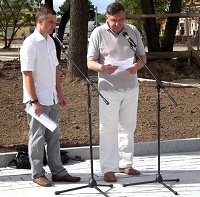 |
| Valdas Balciunas and Vidmantas
Mendelsonas |
Sara Continues:
The plaque which will soon be unveiled tells the dreadful story of more than 3,000 Jews, who 70 years ago were murdered, starting here in this square, and continuing in the nearby Naryshkin Park where they are buried in a mass grave. For the few who escaped, and for their children and grandchildren, the memories are unbearably painful. But there were - in those dark days - a few rays of light. Yes, when it seemed that there was nowhere to turn for help, there were good Lithuanians, noble people, heroes, who risked their own lives and endangered their own families and often suffered severe punishment, people who held out a hand to rescue and give shelter to Jews whose situation was desperate in the face of the Nazi terror. One of those who was saved was a young girl of Zagare -Miriam Schneider-Tiesnesiene. Her son Edmundas Tiesnesis is with us today.
Edmundas Tiesnesis
Text unavailable
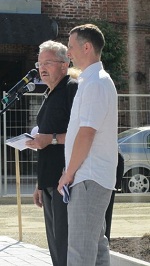 |
| Edmundas Tiesnesis and Valdas
Balciunas |
Sara Continues:
The story of Miriam Schneider is well known, and her rescuers have been recognised by Yad ve Shem, the Holocaust Memorial Authority in Israel. But then only a few weeks ago I learned that there was another story, another Zagare family, who in 1943 hid Jews from the Nazis – the Levinskas family. Their son, Leonas Levinskas was a child at the time – he is with us today, and I'd like to tell you the story. Eduardas Levinskas, his wife Terese and her sister Lilija Vilandaite were appalled at the suffering of the Jews of Zagare. Terese approached the German authorities in Siauliai and asked them to stop persecuting the Jews. For this she was arrested and sentenced to death – and was released only at the last moment. Eduardas was a member of a group of friends who were organising the rescue of Jews from the Siauliai ghetto. The leader of the group was Juozas Petrulis who was recognised by Yad va Shem in 1980. Other members of the group were honoured in 2008.
In 1943 Petrulis managed to smuggle a number of Jews out of the Siauliai ghetto and found hiding places for them with his friends. Among them were Batya Trusfus and her granddaughter Ruth Yoffe. At first they stayed with Petrulis, but it became dangerous and he found shelter for them in Zagare, with the Levinskas family. Ruth, who was 7 years old, was there for only a few days, and was taken in by the Alekna family from Lepine. The grandmother, Batya Trusfus, was hidden and looked after by the Levinskas family for 11 months, in Zagare – until the end of the war. Batya's daughter Eta Trusfus, was also rescued from the ghetto by Petrulis, and sheltered, with two small children, by the Kalendra family. After the war Eta wrote a letter of gratitude to the authorities, and it is this letter which provided the information needed by Yad va Shem to honour Petrulis and the others as the Righteous Among the Nations. But the file on Levinskas was incomplete – and last month I went to Yad va Shem and asked what was missing. Testimony from the survivors I was told – they were looking for Ruth, Batya's granddaughter, who had come to Jerusalem some years ago, and then disappeared. It looked hopeless – but believe it or not, within 24 hours I managed to track down Ruth Yoffe, in Jerusalem – through – what else? the internet. I sat with her, and I heard the story of the child and her grandmother, hidden by Lavinskas, here in Zagare. Today that child is a woman of 75. And she has now given her testimony to Yad va Shem. They will make the award later this year – and Leonas will represent the Levinskas family.
A number of people who have documented the story of the Jewish community of Zagare are with us today. Rod Freedman is a filmmaker who has come from Australia. His award winning documentary film Uncle Chatzkel tells the story of his uncle Chatzkel Lemchen, the famous linguist and lexicographer from Zagare who preserved the Lithuanian language throughout the Soviet Period. Roger Cohen is a distinguished journalist with the New York Times. His article about Isaacas Mendelsonas – the Last Jew in Zagare – brought the story of our community to a worldwide audience. Welcome Roger.
And also from Australia has come Rose Zwi – author of “Last Walk in Naryshkin Park” - a wonderful book which many of you have read – a memoir of her Zagarean family, and a chilling account of the annihilation of the Jewish community. Thank you Rose for making the long and arduous journey to be with us on this day, and thank you for your support, your courage and your spirit: Rose Zwi.
Rose Zwi
Seventy-five years have passed since more than 3,000 Jewish men, women and children were massacred by the Nazi invaders and their Lithuanian helpers. To this day there are those who seek to obliterate the memory of this catastrophe. A strong culture of denial has been forged, distorting history in an attempt to distance themselves from the destruction of Lithuanian Jews who had lived among them for centuries.
However, a younger generation has become aware that historical facts cannot be distorted and buried under concreted killing fields, which holds out great promise for the future.
With the setting up of this memorial, on the very place where the massacre began, the first step has been taken towards propitiating the unquiet spirits of the innocent victims, and salving the conscience of the perpetrators and bystanders. Perhaps, at last, genuine repentance will follow, and reconciliation will be achieved.
My forebears had lived in Zagare for hundreds of years, through good times and through bad times. It was the place they called DER HEIM, Home. Growing up among Jewish immigrants in South Africa whose songs and stories were steeped in nostalgia for Der Heim, Lithuania inevitably became my Home as well. I hoped one day to visit Zagare, Zhager in Yiddish, gather wild strawberries in the forests and stroll through Naryshkin Park as my parents had done in their youth.
That never happened.
All I found of the vibrant Jewish life of my parents’ days, were neglected cemeteries of the past and the mass grave in Naryshkin Park. And, of course, Isaac Mendelson and his wife Aldona, who received me with great generosity of spirit, and filled me in on the fate of my father’s family and the rest of the community.
As I stand before this plaque, I am overwhelmed by the thought that my parents and I might also have lain in the mass grave together with my father’s family, had they not left Zagare in the 1920s. I never knew them, only saw faded photos many years later, but I mourn them to this day.
Remember us, their unquiet spirits seem to call from the grave.
As though one could ever forget.
They do not ask for vengeance; only remembrance.
They will always be remembered.
And, in the language we would have had in common, I say:
MIR ZEINEN DOH! We are here.
|
Rose unveils the plaque and the text is read in English (by
Rod Freedman), Lithuanian (by Valdas Balciunas), and Yiddish
(by Dovid Katz, who also did the translation into Yiddish
for the plaque).
 |
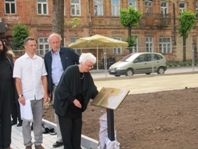 |
| Unveiling
of Plaque |
|
Two letters from Lithuanian officials are read and translated by Zilvinas Beliauskas of the Jewish Public Library in Vilnius.
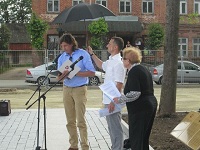 |
|
| Zilvinas Beliauskas reading | |
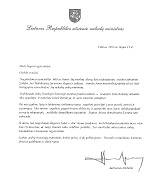 |
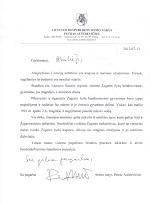 |
|
Click on the letters to
see a larger version and click here and
here to see the translations provided by Zilvinas. |
|
Sara Continues:
And now to end this ceremony – we will say together Kaddish, the Jewish prayer for the dead. We have here some copies of the prayer, in transliteration. Kaddish is the mourners' prayer traditionally recited in memory of the dead – in the synagogue service, at funerals, at anniversaries. And this would seem to be a very appropriate occasion, and a very appropriate place, to say Kaddish for the vanished Jewish community of Zagare. Kaddish is not a prayer of mourning – there is no mention of death. It is in fact a rejoicing, praising and glorifying the Lord – with words taken from the Book of Ezekiel. The language is not Hebrew but Aramaic, a related language, the vernacular tongue that was spoken by Jews all over the world in bygone centuries - the language spoken by Jesus and his disciples. All who wish to may join in reciting Kaddish.
The saying of Kaddish is led by Dovid.
 |
| Dovid Katz leading Kaddish |
